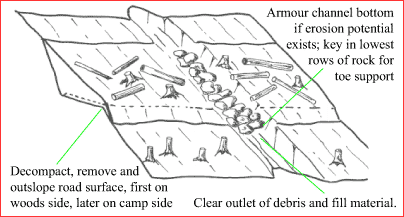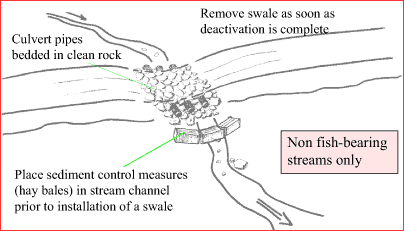|
Forest Road Deactivation Practices
|
|
in the Pacific Northwest
|


|
|
| 18 - Cross-Ditching Practices in Pullback
|
Sequence of Activities, Armoured Swales |
Description
Cross-ditches in pullback are used to restore natural hillslope drainage patterns to their natural (pre-construction) locations. They are placed in natural depressions, gully channels, and swales which have evidence of seepage flow above the road.
Figure 17: Cross-Ditch in Pullback

Suggested Sequence of Activities
- To locate native ground and establish a stable area for the pullback, you must decompact, remove and outslope the road surface on the far side of the cross-ditch.
- Remove the ballast from the cross-ditch location, and excavate a bench to position the machine for further reach downslope. Place as much pullback as possible on the woods side bench.
- Clear the outlet of debris and fill material. Place as much material as possible on the woods side of the cross-ditch. Place remainder on the camp side of the cross-ditch.
- Excavate the cross-ditch from outlet to inlet. Place as much material on woods side of cross-ditch to fill bench to top of cutslope.
- Decompact, remove and outslope the road surface on the camp side prior to finishing cross-ditch pullback.
- Blend slopes of pullback into existing slopes above and below the road, in and out of the gully.
Armoured Swale
This is a rock-filled depression which is removed after deactivation.
Figure 18: Armoured Swale

| 18 - Cross-Ditching Practices in Pullback
|
|
|
 18 Cross-Ditching in Pullback 18 Cross-Ditching in Pullback
|
©1999 - 2002 Flip Productions Limited
Used with permission by CulvertBC
|

